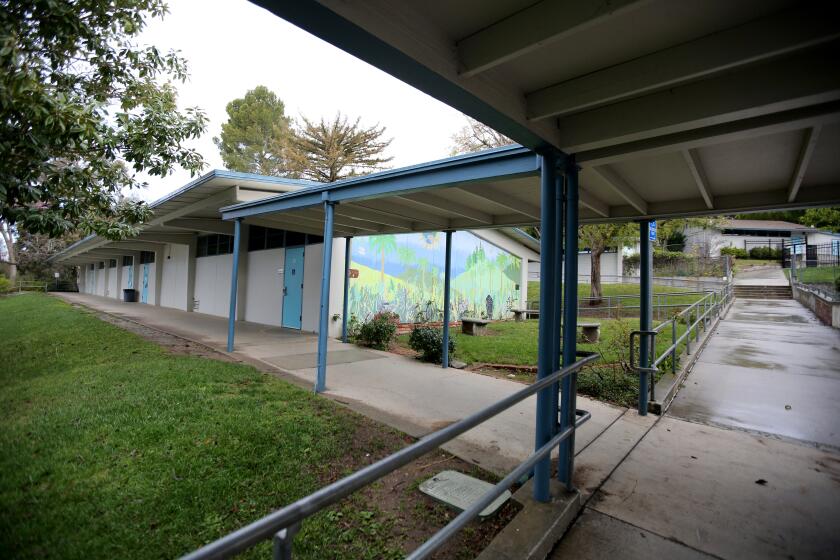School shutdowns threaten to worsen the achievement gap
- Share via
The COVID-19 crisis threatens to undo years of educational efforts to help disadvantaged students catch up to their more affluent classmates. The same old problems — lack of internet access or computers for doing homework, parents who have limited financial or educational resources to help their children with school — are exacerbated now that students are required to learn not in a classroom, but remotely.
No matter how engaging a teacher makes a video lesson, it can’t accomplish a thing if students don’t see it. That’s why, come the fall, these gaps will almost certainly be wider than they’ve been in years.
Some school districts, notably Los Angeles Unified, are making maximum effort to educate all of their students. The district has dedicated $100 million to providing tablet computers to students who have no devices to use at home. It has worked out a deal with a phone company to provide unlimited data so those students have broadband access. A fourth of the money is going to intensive training so that teachers know how to deliver lessons and help their pupils remotely and so that parents and students know how to use the devices and take advantage of the learning experience.
Still, setting up such an effort for a half-million students takes time, and time is in short supply. About 15,000 L.A. Unified high school students aren’t “attending” remote school at all and about a third show up sporadically, according to recent district figures.
Let’s stop pretending that the kids stuck at home during the shutdown are getting ‘home-schooled.’ They’re not. California needs a plan.
On Wednesday, Gov. Gavin Newsom announced that school campuses will be shut down through the end of the academic year. It’s possible to make up for that lost time during the summer, but that would require a costly funding of teacher salaries for weeks or months. And how can L.A. Unified and other school districts reengage students who are not doing their work now, either because they see this as an extended vacation, or because their parents are overwhelmed by loss of income and other burdens and are not holding their feet to the fire?
Worse, not all schools are even making an effort to assure educational “equity” during this period. A recent survey of dozens of large school districts nationwide by the nonprofit Center for Reinventing Public Education found that only a third are working on getting internet-connected devices to those who lack them. Only half are involved in actual lesson planning; the others are instead referring students to optional assignments or pointing them to publicly available educational sites such as the Khan Academy.
In their defense, schools were as blindsided as anyone by how swiftly and completely the pandemic disrupted routines. For years now, they have been kept from giving students access to broadband by the federal government’s overly restrictive E-Rate program, which provides WiFi hot spots to schools at a deep discount but makes it difficult to loan those to students for use at home.
And to their credit, most schools’ first effort has been on safeguarding health. They have been feeding students and often their families who otherwise might have bare pantries, largely through “grab and go” meals. They have informed families about the virus and the best steps for reducing its spread.
Still, the educational efforts by schools nationwide are far too spotty. Many aren’t attempting to provide any real lessons at all, especially after U.S. Education Secretary Betsy DeVos sent out word that schools would still have to meet the needs of special education students. Concerned that they would be sued if they provided any education to abled students that was not also available to disabled students, they simply decided not to educate at all. That’s unacceptable, and DeVos, who has not shown herself a leader during this time of crisis, needs to make clear to schools exactly what does and what doesn’t constitute inclusive education, and to offer reasonable flexibility. Beyond that, she should insist that schools provide evidence that they are gearing up to offer meaningful education to their students, and push for E-Rate funding that will expand access to wireless hot spots to students’ homes.
Today’s students shouldn’t become the lost cohort, left with less ability to succeed academically than those who came before or after them. Above all, it would be grossly unfair to allow disadvantaged students to languish during a long gap in schooling while students whose families have more resources forge ahead.
If government is going to restrict your constitutional rights, however compelling the emergency, the courts will demand more than a slapdash order.
More to Read
A cure for the common opinion
Get thought-provoking perspectives with our weekly newsletter.
You may occasionally receive promotional content from the Los Angeles Times.











